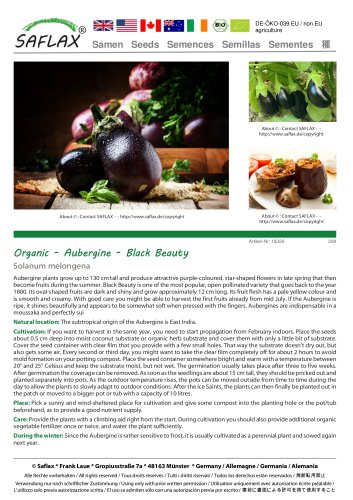
Catalog excerpts

Samen Seeds Semences Semillas Sementes 種 About © : Contact SAFLAX - http://www.saflax.de/copyright About © : Contact SAFLAX - - http://www.saflax.de/copyright About © : Contact SAFLAX - http://www.saflax.de/copyright Organic - Beetroot - Chioggia Beta vulgaris Chioggia is a traditional Italian Beetroot with a pinkish skin and appealing white and red ringed fruit flesh. The white-red rings of the inside make a nice contrast to the usually deep-red colouring, although the rings will fade during cooking. Beetroot is low in calories, very versatile and easy to prepare, and contains high amounts of folic acid, potassium, vitamin B and iron. Beetroot has the sweetest or most aromatic flavour when the fruits are harvested while still young. Grown Beetroots should therefore only be eaten when the size is not more than 6 cm in diameter. Beetroot can be washed, peeled and grated as ingredient for Natural location: Beetroot originated in the coastal areas of the Mediterranean. Today it can be found everywhere in Central Europe. Cultivation: Sowing can be done in spring from mid April until beginning of June. To stimulate germination you should soak the seeds in lukewarm water overnight. Break up the soil properly, mix it with some compost and prepare a seed furrow around 2 cm deep. Place the seeds approximately 25 cm apart from each other inside the seed furrow and cover them with earth. You may as well start propagation in a pot indoors, if you aim for an early harvest of the Beetroot. In that case, sowing takes place already in March. Place the seed container somewhere bright and warm with a temperature between 20° and 25° Celsius and keep the substrate moist, but not wet. The germination usually takes place after three to five weeks. After the seedlings come up in April you can plant your Beetroot out, but it will still need some frost-protection. Place: Pick a sunny and wind-sheltered place for cultivation. Care: Beetroot is relatively undemanding and can grow almost everywhere. Water the plant properly to make sure that its deep reaching roots will get enough water, but avoid water-logging. With the beginning of the tuber formation you should add thinned comfrey or nettle swill to the irrigation water, or you provide the plant with some organic vegetable fertilizer. During the winter: Before the frost you should dig up all remaining tubers. They can still be stored in boxes filled with sand for a long time to come. You can sow the Beetroot during next spring again. © Saflax * Frank Laue * Gropiusstraße 7a * 48163 Münster * Germany / Allemagne / Germania / Alemania Alle Rechte vorbehalten / All rights reserved / Tous droits réservés / Tutti i diritti riservati / Todos los derechos están reservados / 無断転用禁止 Verwendung nur nach schriftlicher Zustimmung / Using only with prior written permission / Utilisation uniquement avec autorisation écrite préalable / L'utilizzo solo previa autorizzazione scritta / El uso se admiten sólo con una autorización previa por e
Open the catalog to page 1All MSL GmbH & Co. KG catalogs and technical brochures
-
Organic - Wild Rocket
1 Pages
-
Levant Cotton
1 Pages
-
Indian Cedar
1 Pages
-
Chicory
1 Pages
-
Common Tobacco
1 Pages
-
Sunflower Titan
1 Pages
-
Organic - Squash - Delicata
1 Pages
-
Organic - Florence Fennel
1 Pages
-
Organic - Nettle
1 Pages
-
Organic - Coriander
1 Pages
-
Organic - Chives
1 Pages
-
Organic - Basil Genovese
1 Pages





























